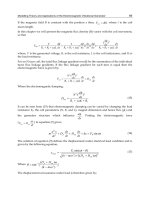Publishing AJAX and PHP - part 5 ppt
Bạn đang xem bản rút gọn của tài liệu. Xem và tải ngay bản đầy đủ của tài liệu tại đây (1.54 MB, 10 trang )
Client-Side Techniques with Smarter JavaScript
<body>
<table id="table">
<tr>
<th id="tableHead">
Product Name
</th>
</tr>
<tr>
<td id="tableFirstLine">
Airplane
</td>
</tr>
<tr>
<td id="tableSecondLine">
Big car
</td>
</tr>
</table>
<br />
<input type="button" value="Set Style 1" onclick="setStyle1();" />
<input type="button" value="Set Style 2" onclick="setStyle2();" />
</body>
</html>
3. Create a file called csstest.js and write the following code in it:
// Change table style to style 1
function setStyle1()
{
// obtain references to HTML elements
oTable = document.getElementById("table");
oTableHead = document.getElementById("tableHead");
oTableFirstLine = document.getElementById("tableFirstLine");
oTableSecondLine = document.getElementById("tableSecondLine");
// set styles
oTable.className = "Table1";
oTableHead.className = "TableHead1";
oTableFirstLine.className = "TableContent1";
oTableSecondLine.className = "TableContent1";
}
// Change table style to style 2
function setStyle2()
{
// obtain references to HTML elements
oTable = document.getElementById("table");
oTableHead = document.getElementById("tableHead");
oTableFirstLine = document.getElementById("tableFirstLine");
oTableSecondLine = document.getElementById("tableSecondLine");
// set styles
oTable.className = "Table2";
oTableHead.className = "TableHead2";
oTableFirstLine.className = "TableContent2";
oTableSecondLine.className = "TableContent2";
}
4. Finally create the CSS file, styles.css:
.Table1
{
border: DarkGreen 1px solid;
background-color: LightGreen;
}
.TableHead1
{
font-family: Verdana, Arial;
font-weight: bold;
40
Chapter 2
font-size: 10pt;
}
.TableContent1
{
font-family: Verdana, Arial;
font-size: 10pt;
}
.Table2
{
border: DarkBlue 1px solid;
background-color: LightBlue;
}
.TableHead2
{
font-family: Verdana, Arial;
font-weight: bold;
font-size: 10pt;
}
.TableContent2
{
font-family: Verdana, Arial;
font-size: 10pt;
}
5. Load http://localhost/ajax/foundations/css/css.html in your web browser,
and test that your buttons work as they should.
Figure 2.5: Table with CSS and JavaScript
What Just Happened?
Your
styles.css file contains two sets of styles that can be applied to the table in csstest.html.
When the user clicks one of the Set Style buttons, the JavaScript DOM is used to assign those
styles to the elements of the table.
In the first part of the
SetStyle methods, we use the getElementByID function to obtain
references to the HTML elements that we want to apply CSS styles to:
// obtain references to HTML elements
oTable = document.getElementById("table");
oTableHead = document.getElementById("tableHead");
oTableFirstLine = document.getElementById("tableFirstLine");
41
oTableSecondLine = document.getElementById("tableSecondLine");
Client-Side Techniques with Smarter JavaScript
As with many other web development tasks, manipulating CSS can be the subject of
significant inconsistencies between different browsers. For example, in the previous code
snippet, try to rename the object names to be the same as their associated HTML
elements (such as renaming oTable to table) to see Internet Explorer stop working.
Internet Explorer doesn't like it if there's already an object with that ID in the HTML file.
This problem doesn't make much sense because the objects have different scopes, but
better watch out if you want your code to work with Internet Explorer as well.
Once initializing these objects, the safe way that works with all browsers to set the elements' CSS
style is to use their
className property:
// set styles
oTable.className = "Table1";
oTableHead.className = "TableHead1";
oTableFirstLine.className = "TableContent1";
oTableSecondLine.className = "TableContent1";
Using the XMLHttpRequest Object
XMLHttpRequest is the object that enables the JavaScript code to make asynchronous HTTP server
requests. This functionality allows you to make HTTP requests, receive responses, and update
parts of the page completely in the background, without the user experiencing any visual
interruptions. This is very important because one can keep the user interface responsive while
interrogating the server for data.
The
XMLHttpRequest object was initially implemented by Microsoft in 1999 as an ActiveX object
in Internet Explorer, and eventually became de facto standard for all the browsers, being supported
as a native object by all modern web browsers except Internet Explorer 6.
Note that even if XMLHttpRequest has become a de facto standard in the web browsers, it
is not a W3C standard. Similar functionality is proposed by the W3C DOM Level 3 Load
and Save specification standard, which hasn't been implemented yet by web browsers.
The typical sequence of operations when working with XMLHttpRequest is as follows:
1. Create an instance of the XMLHttpRequest object.
2. Use the XMLHttpRequest object to make an asynchronous call to a server page,
defining a callback function that will be executed automatically when the server
response is received.
1. Deal with server's response in the callback function.
2. Go to step 2.
Let's now see how to do these steps with real code.
42
Chapter 2
Creating the XMLHttpRequest Object
The XMLHttpRequest is implemented in different ways by the browsers. In Internet Explorer 6 and
older,
XMLHttpRequest is implemented as an ActiveX control, and you instantiate it like this:
xmlhttp = new ActiveXObject("Microsoft.XMLHttp");
For the other web browsers, XMLHttpRequest is a native object, so you create instances of it
like this:
xmlhttp = new XMLHttpRequest();
The ActiveX XMLHttp library comes is many more flavors and versions that you could
imagine. Each piece of Microsoft software, including Internet Explorer and MDAC, came
with new versions of this ActiveX control. Microsoft.XMLHTTP is the oldest and can be
safely used for basic operations, while the newer versions have performance and feature
improvements. You will learn how to automatically use a more recent version.
A simplified version of the code we will use for cross-browser XMLHttpRequest instantiation
throughout this book is:
// creates an XMLHttpRequest instance
function createXmlHttpRequestObject()
{
// will store the reference to the XMLHttpRequest object
var xmlHttp;
// this should work for all browsers except IE6 and older
try
{
// try to create XMLHttpRequest object
xmlHttp = new XMLHttpRequest();
}
catch(e)
{
// assume IE6 or older
try
{
xmlHttp = new ActiveXObject("Microsoft.XMLHttp");
}
catch(e) { }
}
// return the created object or display an error message
if (!xmlHttp)
alert("Error creating the XMLHttpRequest object.");
else
return xmlHttp;
}
This function is supposed to return an instance of the XMLHttpRequest object. The functionality
relies on the JavaScript
try/catch construct.
The
try/catch construct, initially implemented with OOP languages, offers a powerful
exception-handling technique in JavaScript. Basically, when an error happens in JavaScript code,
an exception is thrown. The exception has the form of an object that contains the error's
(exception's) details. Using the
try/catch syntax, you can catch the exception and handle it
locally, so that the error won't be propagated to the user's browser.
43
Client-Side Techniques with Smarter JavaScript
44
The try/catch syntax is as follows:
try
{
// code that might generate an exception
}
catch (e)
{
// code that is executed only if an exception was thrown by the try block
// (exception details are available through the e parameter)
}
You place any code that might generate errors inside the try block. If an error happens, the
execution is passed immediately to the
catch block. If no error happens inside the try block, then
the code in the
catch block never executes.
Run-time exceptions propagate from the point they were raised, up through the call stack of your
program. If you don't handle the exception locally, it will end up getting caught by the web
browser, which may display a not very good looking error message to your visitor.
The way you respond to each exception depends very much on the situation at hand. Sometimes you
will simply ignore the error, other times you will flag it somehow in the code, or you will display an
error message to your visitor. Rest assured that in this book you will meet all kinds of scenarios.
In our particular case, when we want to create an
XMLHttpRequest object, we will first try to
create the object as if it was a native browser object, like this:
// this should work for all browsers except IE6 and older
try
{
// try to create XMLHttpRequest object
xmlHttp = new XMLHttpRequest();
}
Internet Explorer 7, Mozilla, Opera, and other browsers will execute this piece of code just fine,
and no error will be generated, because
XMLHttpRequest is a natively supported. However, Internet
Explorer 6 and its older versions won't recognize the
XMLHttpRequest object, an exception will be
generated, and the execution will be passed to the
catch block. For Internet Explorer 6 and older
versions, the
XMLHttpRequest object needs to be created as an ActiveX control:
catch(e)
{
// assume IE6 or older
try
{
xmlHttp = new ActiveXObject("Microsoft.XMLHttp");
}
catch(e) { }
}
The larger the number of JavaScript programmers, the more XMLHttpRequest object creation
methods you will see, and surprisingly enough, they will all work fine. In this book, we prefer the
method that uses
try and catch to instantiate the object, because we think it has the best chance of
working well with future browsers, while doing a proper error checking without consuming too
many lines of code.
Chapter 2
You could, for example, check whether your browser supports XMLHttpRequest before trying to
instantiate it, using the
typeof function:
if (typeof XMLHttpRequest != "undefined")
xmlHttp = new XMLHttpRequest();
Using typeof can often prove to be very helpful. In our particular case, using typeof doesn't
eliminate the need to guard against errors using
try/catch, so you would just end up typing more
lines of code.
An alternative way to achieve the same functionality is by using a JavaScript feature called
object detection. This feature allows you to check whether a particular object is supported by
the browser, and works like this:
if (window.XMLHttpRequest)
xmlHttp = new XMLHttpRequest();
For example, by checking for window.ActiveX you can find if the browser is Internet Explorer.
Once again, we're not using this technique because it would simply add more lines of code without
bringing any benefits; but the ideas are good to keep nevertheless.
If you decide to use object detection, please be sure to check for
XMLHttpRequest first before
checking for ActiveX support. The reason for this recommendation is Internet Explorer 7, which
supports both ActiveX and
XMLHttpRequest; the latter is better because it gives you the latest
object version. With ActiveX, as you will see, you need to write quite a bit of code to ensure that
you get a recent version, although you still are not guaranteed to get the latest one.
At the end of our
createXmlHttpRequestObject function, we test that after all the efforts, we
have ended up obtaining a valid
XMLHttpRequest instance:
// return the created object or display an error message
if (!xmlHttp)
alert("Error creating the XMLHttpRequest object.");
else
return xmlHttp;
The reverse effect of object detection is even nicer than the feature itself. Object
detection says that JavaScript will evaluate a valid object instance, such as (xmlHttp), to
true. The nice thing is that (!xmlHttp) expression returns true not only if xmlHttp is
false, but also if it is null or undefined.
Creating Better Objects for Internet Explorer
The one thing that can be improved about the createXmlHttpRequestObject function is to have it
recognize the latest version of the ActiveX control, in case the browser is Internet Explorer 6. In most
cases, you can rely on the basic functionality provided by
ActiveXObject("Microsoft.XMLHttp"), but
if you want to try using a more recent version, you can.
The typical solution is to try creating the latest known version, and if it fails, ignore the error and
retry with an older version, and so on until you get an object instead of an exception. The latest
prog ID of the
XMLHTTP ActiveX Object is MSXML2.XMLHTTP.6.0. For more details about these
prog IDs, or to simply get a better idea of the chaos that lies behind them, feel free to read a
resource such as
45
Client-Side Techniques with Smarter JavaScript
46
Here is the upgraded version of createXmlHttpRequestObject. The new bits are highlighted.
// creates an XMLHttpRequest instance
function createXmlHttpRequestObject()
{
// will store the reference to the XMLHttpRequest object
var xmlHttp;
// this should work for all browsers except IE6 and older
try
{
// try to create XMLHttpRequest object
xmlHttp = new XMLHttpRequest();
}
catch(e)
{
// assume IE6 or older
var XmlHttpVersions = new Array('MSXML2.XMLHTTP.6.0',
'MSXML2.XMLHTTP.5.0',
'MSXML2.XMLHTTP.4.0',
'MSXML2.XMLHTTP.3.0',
'MSXML2.XMLHTTP',
'Microsoft.XMLHTTP');
// try every prog id until one works
for (var i=0; i<XmlHttpVersions.length && !xmlHttp; i++)
{
try
{
// try to create XMLHttpRequest object
xmlHttp = new ActiveXObject(XmlHttpVersions[i]);
}
catch (e) {} // ignore potential error
}
}
// return the created object or display an error message
if (!xmlHttp)
alert("Error creating the XMLHttpRequest object.");
else
return xmlHttp;
}
If this code looks a bit scary, rest assured that the functionality is quite simple. First, it tries to
create the
MSXML2.XMLHttp.6.0 ActiveX object. If this fails, the error is ignored (note the empty
catch block there), and the code continues by trying to create an
MSXML2.XMLHTTP.5.0 object, and
so on. This continues until one of the object creation attempts succeeds.
Perhaps, the most interesting thing to note in the new code is the way we use object detection
(!xmlHttp) to ensure that we stop looking for new prog IDs after the object has been created,
effectively interrupting the execution of the
for loop.
Initiating Server Requests Using XMLHttpRequest
After creating the XMLHttpRequest object you can do lots of interesting things with it. Although, it
has different ways of being instantiated, depending on the version and browser, all the instances of
XMLHttpRequest are supposed to share the same API (Application Programming Interface) and
support the same functionality. (In practice, this can't be guaranteed, since every browser has its
own separate implementation.)
Chapter 2
You will learn the most interesting details about XMLHttpRequest by practice, but for a quick
reference here are the object's methods and properties:
Method/Property Description
abort()
Stops the current request.
getAllResponseHeaders()
Returns the response headers as a string.
getResponseHeader("headerLabel")
Returns a single response header as a string.
open("method", "URL"[, asyncFlag[,
"userName"[, "password"]]])
Initializes the request parameters.
send(content)
Performs the HTTP request.
setRequestHeader("label", "value")
Sets a label/value pair to the request header.
onreadystatechange
Used to set the callback function that handles request
state changes.
readyState
Returns the status of the request:
0 = uninitialized
1 = loading
2 = loaded
3 = interactive
4 = complete
responseText
Returns the server response as a string.
responseXML
Returns the server response as an XML document.
Status
Returns the status code of the request.
statusText
Returns the status message of the request.
The methods you will use with every server request are
open and send. The open method
configures a request by setting various parameters, and
send makes the request (accesses the
server). When the request is made asynchronously, before calling
send you will also need to set
the
onreadystatechange property with the callback method to be executed when the status of the
request changes, thus enabling the AJAX mechanism.
The
open method is used for initializing a request. It has two required parameters and a few
optional ones. The
open method doesn't initiate a connection to the server; it is only used to set the
connection options. The first parameter specifies the method used to send data to the server page,
and it can have a value of
GET, POST, or PUT. The second parameter is URL, which specifies where
you want to send the request. The
URL can be complete or relative. If the URL doesn't specify a
resource accessible via HTTP, the first parameter is ignored.
47
Client-Side Techniques with Smarter JavaScript
The third parameter of open, called async, specifies whether the request should be handled
asynchronously;
true means that script processing carries on after the send() method returns
without waiting for a response;
false means that the script waits for a response before
continuing processing, freezing the web page functionality. To enable asynchronous processing,
you will seed to set
async to true, and handle the onreadystatechange event to process the
response from the server.
When using GET to pass parameters, you send the parameters using the URL's query string, as
in
T
http://localhost/ajax/test.php?param1=x¶m2=y. This server request passes two
parameters—a parameter called
param1 with the value x, and a parameter called param2 with the
value
y.
// call the server page to execute the server side operation
xmlHttp.open("GET", "http://localhost/ajax/test.php?param1=x¶m2=y", true);
xmlHttp.onreadystatechange = handleRequestStateChange;
xmlHttp.send(null);
When using POST, you send the query string as a parameter of the send method, instead of joining
it on to the base URL, like this:
// call the server page to execute the server side operation
xmlHttp.open("POST", "http://localhost/ajax/test.php", true);
xmlHttp.onreadystatechange = handleRequestStateChange;
xmlHttp.send("param1=x¶m2=y");
The two code samples should have the same effects. In practice, using GET can help with
debugging because you can simulate
GET requests with a web browser, so you can easily see with
your own eyes what your server script generates. The
POST method is required when sending data
larger than 512 bytes, which cannot be handled by
T
GET.
In our examples, we will place the code that makes the HTTP request inside a function called
process() in the JavaScript file. The minimal implementation, which is quite fragile and doesn't
implement any error-handling techniques, looks like this:
function process()
{
// call the server page to execute the server side operation
xmlHttp.open("GET", "server_script.php", true);
xmlHttp.onreadystatechange = handleRequestStateChange;
xmlHttp.send(null);
}
This method has the following potential problems:
•
process() may be executed even if xmlHttp doesn't contain a valid
XMLHttpRequest instance. This may happen if, for example, the user's browser
doesn't support
XMLHttpRequest. This would cause an unhandled exception to
happen, so our other efforts to handle errors don't help very much if we aren't
consistent and do something about the
process function as well.
•
process() isn't protected against other kinds of errors that could happen. For
example, as you will see later in this chapter, some browsers will generate a security
exception if they don't like the server you want to access with the
XMLHttpRequest
object (more on security in Chapter 3).
48
Chapter 2
The safer version of process() looks like that:
// called to read a file from the server
function process()
{
// only continue if xmlHttp isn't void
if (xmlHttp)
{
// try to connect to the server
try
{
// initiate reading the a file from the server
xmlHttp.open("GET", "server_script.php", true);
xmlHttp.onreadystatechange = handleRequestStateChange;
xmlHttp.send(null);
}
// display the error in case of failure
catch (e)
{
alert("Can't connect to server:\n" + e.toString());
}
}
}
If xmlHttp is null (or false) we don't display yet another message, as we assume a message was
already displayed by the
createXmlHttpRequestObject function. We make sure to display any
other connection problems though.
Handling Server Response
When making an asynchronous request (such as in the code snippets presented earlier), the
execution of
xmlHttp.send() doesn't freeze until the server response is received; instead, the
execution continues normally. The
handleRequestStateChange method is the callback method
that we set to handle request state changes. Usually this is called four times, for each time the
request enters a new stage. Remember the
readyState property can be any of the following:
0 = uninitialized
1 = loading
2 = loaded
3 = interactive
4 = complete
Except state 3, all the others are pretty self-explaining names. The interactive state is an
intermediate state when the response has been partially received. In our AJAX applications we
will only use the complete state, which marks that a response has been received from the server.
The typical implementation of
handleRequestStateChange is shown in the following code
snippet, which highlights the portion where you actually get to read the response from the server:
// function executed when the state of the request changes
function handleRequestStateChange()
{
// continue if the process is completed
if (xmlHttp.readyState == 4)
{
// continue only if HTTP status is "OK"
if (xmlHttp.status == 200)
{
// retrieve the response
response = xmlHttp.responseText;
49









